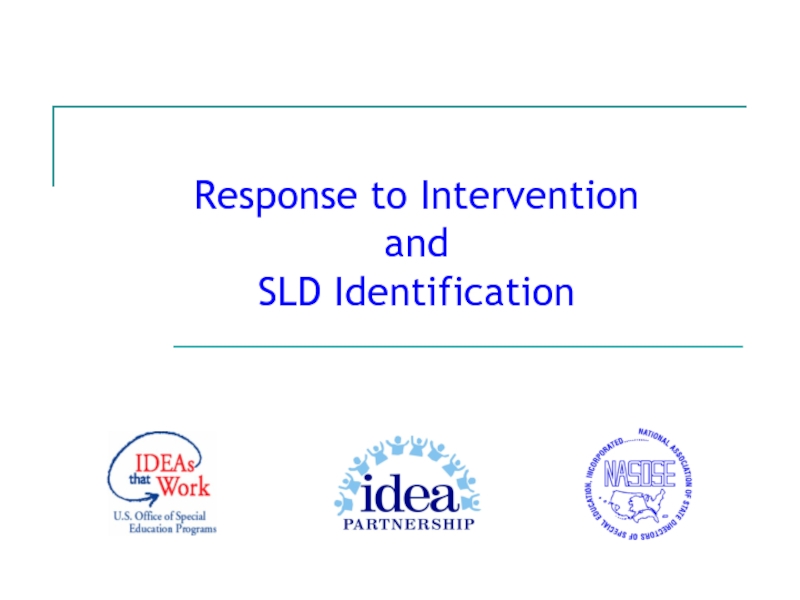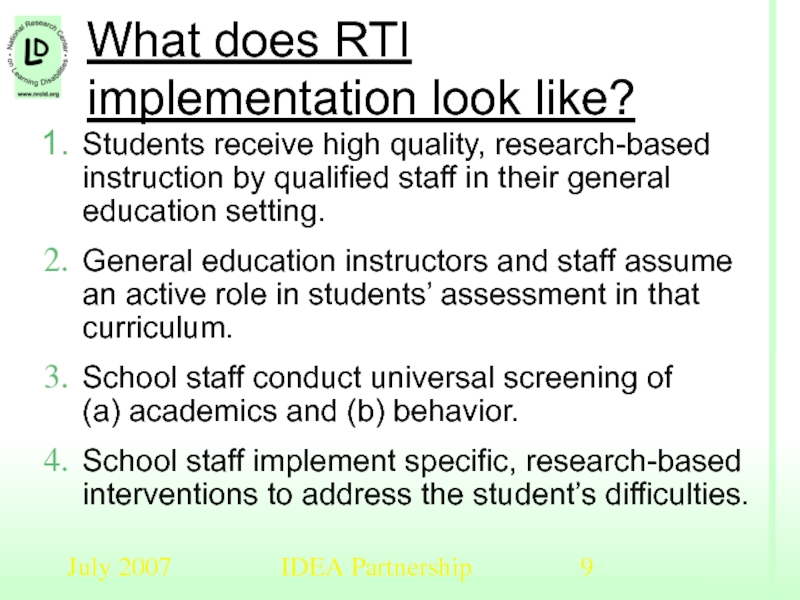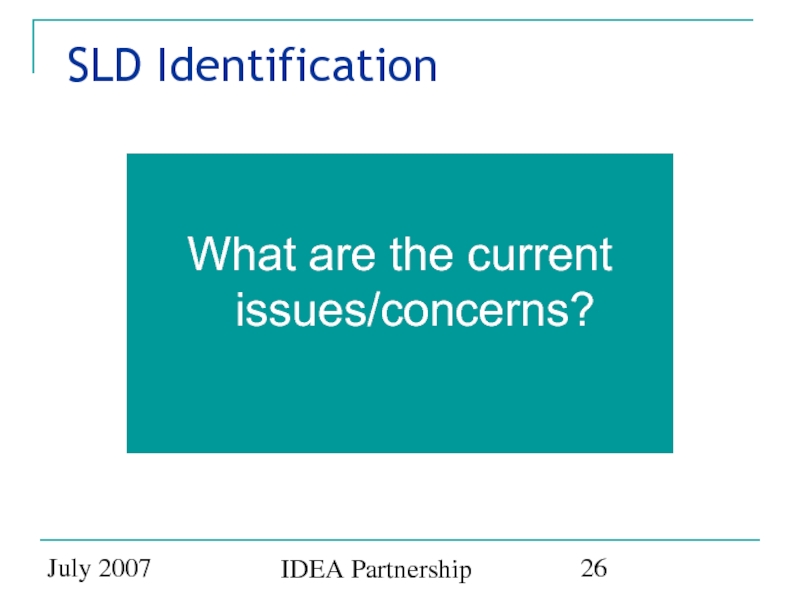- Главная
- Разное
- Дизайн
- Бизнес и предпринимательство
- Аналитика
- Образование
- Развлечения
- Красота и здоровье
- Финансы
- Государство
- Путешествия
- Спорт
- Недвижимость
- Армия
- Графика
- Культурология
- Еда и кулинария
- Лингвистика
- Английский язык
- Астрономия
- Алгебра
- Биология
- География
- Детские презентации
- Информатика
- История
- Литература
- Маркетинг
- Математика
- Медицина
- Менеджмент
- Музыка
- МХК
- Немецкий язык
- ОБЖ
- Обществознание
- Окружающий мир
- Педагогика
- Русский язык
- Технология
- Физика
- Философия
- Химия
- Шаблоны, картинки для презентаций
- Экология
- Экономика
- Юриспруденция
Response to Intervention and SLD Identification презентация
Содержание
- 1. Response to Intervention and SLD Identification
- 2. July 2007 IDEA Partnership The IDEA Partnership
- 3. July 2007 IDEA Partnership Session Overview RTI
- 4. July 2007 IDEA Partnership RTI Process What is it?
- 5. July 2007 IDEA Partnership RTI is… the
- 6. July 2007 IDEA Partnership What do we
- 7. July 2007 IDEA Partnership Goals of RTI
- 8. July 2007 IDEA Partnership RTI Process
- 9. July 2007 IDEA Partnership What does RTI
- 10. July 2007 IDEA Partnership Other features of
- 11. July 2007 IDEA Partnership Intervention Levels Two
- 12. July 2007 IDEA Partnership
- 13. July 2007 IDEA Partnership Primary Instruction
- 14. July 2007 IDEA Partnership Which students may
- 15. July 2007 IDEA Partnership Differentiated Instruction Meeting
- 16. July 2007 IDEA Partnership Differentiating Instruction…
- 17. July 2007 IDEA Partnership Secondary Intervention
- 18. July 2007 IDEA Partnership Standard Treatment Protocol
- 19. July 2007 IDEA Partnership What types of
- 20. July 2007 IDEA Partnership Tertiary Intervention
- 21. July 2007 IDEA Partnership Problem-Solving Method
- 22. July 2007 IDEA Partnership Determining interventions Use
- 23. July 2007 IDEA Partnership Explicit decision rules
- 24. July 2007 IDEA Partnership Program/Process Evaluation
- 25. July 2007 IDEA Partnership Advantages of RTI
- 26. July 2007 IDEA Partnership SLD Identification
- 27. July 2007 IDEA Partnership Current “wait to fail” model Misidentification Disproportionality Identification of SLD
- 28. July 2007 IDEA Partnership Researcher Roundtable on
- 29. July 2007 IDEA Partnership Researcher Roundtable on
- 30. July 2007 IDEA Partnership SLD Determination and
- 31. July 2007 IDEA Partnership RTI as part
- 32. July 2007 IDEA Partnership Explicit decision rules
- 33. July 2007 IDEA Partnership
- 34. July 2007 IDEA Partnership Progress Monitoring for
- 35. July 2007 IDEA Partnership Progress Monitoring for
- 36. July 2007 IDEA Partnership Progress Monitoring for
- 37. July 2007 IDEA Partnership Progress Monitoring for
- 38. July 2007 IDEA Partnership Progress Monitoring for
- 39. July 2007 IDEA Partnership Monitoring progress… How
- 40. July 2007 IDEA Partnership RTI Symposium Participants
- 41. July 2007 IDEA Partnership Regional Resource Centers
- 42. July 2007 IDEA Partnership For More Information:
- 43. July 2007 IDEA Partnership Reflections! Questions?
Слайд 2July 2007
IDEA Partnership
The IDEA Partnership wishes to acknowledge the work of
Slides displaying the National Research Center on Learning Disabilities (NRCLD) logo contain original text presented by Lou Danielson on June 21, 2006 to the members of the IDEA Partnership Focus Group and/or Daryl Mellard on April 1, 2005 to the members of the National Association of School Psychologists (NASP).
-and-
We are deeply grateful for being allowed to adapt the original presentations in order to provide additional access to all education stakeholders.
Слайд 3July 2007
IDEA Partnership
Session Overview
RTI Process
What is it?
What might it look like
SLD Identification
What are the current issues/problems?
What data can RTI yield that will assist in SLD determination?
Resources for further consideration
Слайд 5July 2007
IDEA Partnership
RTI is…
the practice of providing high-quality
instruction/intervention matched to student
and
using learning rate over time
and level of performance
to
inform educational decisions
Слайд 6July 2007
IDEA Partnership
What do we mean by RTI?
RTI has two goals:
2 or more tiers of increasingly intense interventions.
Use a problem solving model or standardized treatment protocol for intervention tiers.
Implementation of a differentiated curriculum with different instructional methods.
Varied duration, frequency, and time of interventions, and
Explicit decision rules for judging learners’ progress.
Слайд 7July 2007
IDEA Partnership
Goals of RTI
Prevention of academic/behavior problems
Attend to skill gaps
Provide interventions/instruction early
Close skill gaps to prevent failure
Determination of eligibility as a student with a specific learning disability
Pattern of inadequate response to interventions may result in referral to special education
Student intervention response data are considered for SLD eligibility
Слайд 9July 2007
IDEA Partnership
What does RTI implementation look like?
Students receive high quality,
General education instructors and staff assume an active role in students’ assessment in that curriculum.
School staff conduct universal screening of (a) academics and (b) behavior.
School staff implement specific, research-based interventions to address the student’s difficulties.
Слайд 10July 2007
IDEA Partnership
Other features of RTI
Continuous progress monitoring of student performance
School staff use progress-monitoring data and decision rules to determine interventions’ effectiveness and needed modifications.
Systematic assessment of the fidelity or integrity with which instruction and interventions are implemented.
Слайд 11July 2007
IDEA Partnership
Intervention Levels
Two or more tiers
Tiers include increasing levels of
Primary Instruction -- differentiated curriculum and instruction for all students
Secondary Interventions -- Targeted interventions for students at-risk
Tertiary Interventions -- Strategic/Intense interventions for students with intensive needs
Слайд 12July 2007
IDEA Partnership
Primary Instruction (~80%)
School-/Classroom-wide
Systems for All Students,
Staff and Settings
Secondary
Specialized Group
Systems for Students with
At Risk Performance
Tertiary Intervention (~5%)
Specialized Individualized
Systems for Students with Intensive Needs
~80% of Students
~15%
~5%
Continuum of School-Wide Instruction
Adapted from”What is School-Wide PBS?”
Слайд 13July 2007
IDEA Partnership
Primary Instruction
Expectation = 80% or more of students
Assessment = Universal screenings for academics and social/emotional growth (behaviors)
Intervention = Through differentiated instructional practices
Roles and responsibilities = primarily the general education teacher
Слайд 14July 2007
IDEA Partnership
Which students may have a learning gap?
Low income
Culturally
English language learners
Special education
Disengaged
Male or female
Career and technical education
Gifted education
Source: National Education Association IDEA Resource Cadre presentation on Differentiated Instruction, developed in collaboration with Deborah E Burns, Curriculum Coordinator, Cheshire Connecticut Public Schools and Kathleen Whitmire, Director, School Services in Speech-Language Pathology, American Speech and Hearing Association
Слайд 15July 2007
IDEA Partnership
Differentiated Instruction
Meeting diverse needs of diverse student population
Differentiating based
Choosing curriculum components to differentiate
Within the core curriculum
Consistent with state learning standards
Слайд 16July 2007
IDEA Partnership
Differentiating Instruction…
Objective
Assessment
Intro
Teaching
Learning
Products
Resources
Grouping
Extension
Pacing
CORE CURRICULUM
Source: National Education Association IDEA Resource
Слайд 17July 2007
IDEA Partnership
Secondary Intervention
Expectation = 15% of students may be
Assessment = progress monitoring of student response to specific intervention
Intervention = standard protocol treatment intervention as available from the research; evidence-based intervention as available in the literature
Roles and responsibilities = variety of personnel as determined at the local site
Слайд 18July 2007
IDEA Partnership
Standard Treatment Protocol Approach To Responsive-to-Intervention
The standard treatment is
The bad news is that all students receive the same intervention
The good news is that the interventions are well-specified, sequenced with clear outcomes
The interventions are more likely to be delivered with fidelity; training is consistent
Increases the consistency of services; easy to check for implementation
Слайд 19July 2007
IDEA Partnership
What types of interventions?
Standard Treatment Protocol Interventions
From scientific-based education
Evidence-based Interventions
From education research
Experiential-based Interventions
From best practice with like students
Слайд 20July 2007
IDEA Partnership
Tertiary Intervention
Expectation = 5% of students may be
Assessment = progress monitoring of student response to specific intervention
Intervention = standard protocol treatment intervention as available from the research; evidence-based intervention as available in the literature; unique intervention based on teacher expertise
Roles and responsibilities = variety of personnel as determined at the local site
Слайд 22July 2007
IDEA Partnership
Determining interventions
Use of problem-solving methodology
Define problem
Brainstorm solutions
Choose intervention with
Standard treatment protocol intervention
Evidence-based intervention
Monitor and assess intervention outcomes
Слайд 23July 2007
IDEA Partnership
Explicit decision rules
Necessary for determining expected response or inadequate
Considering
Expected level of achievement of peer group
Target for this student
Movement toward the target
Trajectory of improvement, or lack thereof
Слайд 24July 2007
IDEA Partnership
Program/Process Evaluation
Systematic and ongoing
Assess integrity/fidelity of implementation of
Assess integrity of implementation of overall process
High quality, research-based instruction
Screening and progress monitoring
Data analysis
Problem-solving
Data-driven decision-making
Слайд 25July 2007
IDEA Partnership
Advantages of RTI Approach
Provides instructional assistance in a timely
Helps ensure a student’s poor academic performance is not due to poor instruction or inappropriate curriculum
Informs teacher and improves instruction because assessment data are collected and closely linked to interventions
Слайд 27July 2007
IDEA Partnership
Current “wait to fail” model
Misidentification
Disproportionality
Identification of SLD
Слайд 28July 2007
IDEA Partnership
Researcher Roundtable on Specific Learning Disabilities
SLD is a valid
SLD are disorders of learning and cognition intrinsic to the individual(s)
Each disorder significantly affects a relatively narrow range of academic and performance outcomes
SLD may occur in combination with other disabling conditions, but are not due primarily to other conditions
Adapted from opening remarks by Lou Danielson, Ph.D., Director, Research to Practice Division, Office of Special Education Programs to the National SEA Conference on SLD Determination, Kansas City, MO, April 19-21, 2006
Слайд 29July 2007
IDEA Partnership
Researcher Roundtable on Response to Intervention
There should be alternate
Response to quality intervention is the most promising method of alternate identification
Can promote effective practices in schools
Can help to close the gap between identification and treatment
RTI should be based on problem solving models that use progress monitoring to gauge the intensity of intervention in relation to the student’s response to intervention
Adapted from opening remarks by Lou Danielson, Ph.D., Director, Research to Practice Division, Office of Special Education Programs to the National SEA Conference on SLD Determination, Kansas City, MO, April 19-21, 2006
Слайд 30July 2007
IDEA Partnership
SLD Determination and IDEA 2004
New language in the law:
“…a local education agency may use a process that determines if the child responds to scientific, research-based intervention as a part of the evaluation procedures…”
Sec. 614(b)6B [emphasis added]
In the special education research literature, the process mentioned in this language is generally considered as referring to RTI.
From opening remarks by Lou Danielson, Ph.D., Director, Research to Practice Division, Office of Special Education Programs to the National SEA Conference on SLD Determination, Kansas City, MO, April 19-21, 2006
Слайд 31July 2007
IDEA Partnership
RTI as part of SLD Identification
What data can RTI
Слайд 32July 2007
IDEA Partnership
Explicit decision rules
Necessary for determining expected response or inadequate
Considering
Expected level of achievement of peer group
Target for this student
Movement toward the target
Trajectory of improvement, or lack thereof
Слайд 33July 2007
IDEA Partnership
Classroom teacher screening for a specific indicator…
Baseline
Source: Sharon R
Слайд 34July 2007
IDEA Partnership
Progress Monitoring for a specific intervention…
Baseline
Gened instruction
Targeted Intervention Initiated
Source:
Слайд 35July 2007
IDEA Partnership
Progress Monitoring for a specific intervention…
Baseline
Gened instruction
Targeted Intervention Initiated
AIMLINE
Kia’s
Successful Intervention !!
Source: Sharon R Schultz, from a presentation/facilitated dialogue entitled RTI: Schoolwide Transformation (Spring 2007)
Слайд 36July 2007
IDEA Partnership
Progress Monitoring for a specific intervention…
Baseline
Gened instruction
Targeted Intervention Initiated
AIMLINE
Kia’s
Unsuccessful Intervention !!
Source: Sharon R Schultz, from a presentation/facilitated dialogue entitled RTI: Schoolwide Transformation (Spring 2007)
Слайд 37July 2007
IDEA Partnership
Progress Monitoring for a specific intervention…
Baseline
Gened instruction
Targeted Intervention Initiated
AIMLINE
Kia’s
Unsuccessful Intervention !!
Rule of Four
Source: Sharon R Schultz, from a presentation/facilitated dialogue entitled RTI: Schoolwide Transformation (Spring 2007)
Слайд 38July 2007
IDEA Partnership
Progress Monitoring for a specific intervention…
Baseline
Gened instruction
Targeted Intervention Initiated
AIMLINE
Kia’s
Another targeted intervention -or- intense intervention?
Rule of Four
Targeted Intervention Initiated
Source: Sharon R Schultz, from a presentation/facilitated dialogue entitled RTI: Schoolwide Transformation (Spring 2007)
Слайд 39July 2007
IDEA Partnership
Monitoring progress…
How often will skill probes be administered?
How many
What is a pattern of inadequate response?
How many different interventions at each tier?
How much time in each tier?
Слайд 40July 2007
IDEA Partnership
RTI Symposium
Participants included advocates, instructional staff, researchers, and state-level
Speakers shared knowledge / expertise, organized around six questions related to RTI implementation in both school districts and research sites
Symposium materials (e.g., papers, PowerPoint presentations, video highlights) are available on our website: www.nrcld.org
Слайд 41July 2007
IDEA Partnership
Regional Resource Centers
Federal Resource Center
Michele Rovins, Director
Region 1: Northeast
Kristin
Region 2: Mid-South
Kenneth Warlick, Director
Region 3: Southeast
Elizabeth Beale, Director
Region 4: North Central
Michael Sharpe, Director
Region 5: Mountain Plains
John Copenhaver, Director
Region 6: Western
Caroline Moore, Director
www.rrfcnetwork.org
Слайд 42July 2007
IDEA Partnership
For More Information:
IDEA Partnership’s RTI Initiative
Website: www.ideapartnership.org
A Partnership
Many Journals, Many Voices
Results for Kids: Resources
















































